| October 20, 2008 |  |
MarsDaily Advertising Kit |
| Previous Issues | Oct 19 | Oct 18 | Oct 17 | Oct 16 | Oct 15 |
Shooting Life On Mars Moffett Field CA (SPX) Oct 20, 2008
Moffett Field CA (SPX) Oct 20, 2008Scientists have detected minuscule traces of cells in a mineral on Earth that has also been detected on Mars. The results, obtained using a technique developed at the U.S. Department of Energy's Idaho National Laboratory, could help mission scientists choose martian surface samples with the most promise for yielding signs of life. INL's instrument blasts off tiny bits of mineral and looks ... more HiRISE Camera Reveals Rare Polar Martian Impact Craters  Tuscon AZ (SPX) Oct 20, 2008
Tuscon AZ (SPX) Oct 20, 2008An odd, solitary hill rising part-way down an eroding slope in Mars' north polar layered terrain may be the remnant of a buried impact crater, suggests a University of Arizona planetary scientist who studied the feature in a new, detailed image from the HiRISE camera onboard NASA's Mars Reconnaissance Orbiter. HiRISE, or the High Resolution Imaging Science Experiment, headed by Alfred ... more HiRISE Camera Reveals Rare Polar Martian Impact Craters  Tuscon AZ (SPX) Oct 17, 2008
Tuscon AZ (SPX) Oct 17, 2008An odd, solitary hill rising part-way down an eroding slope in Mars' north polar layered terrain may be the remnant of a buried impact crater, suggests a University of Arizona planetary scientist who studied the feature in a new, detailed image from the HiRISE camera onboard NASA's Mars Reconnaissance Orbiter. The north polar layered deposits are stacked up to several kilometers thick and ... more Phoenix Mars Mission Honored By Popular Mechanics  Pasadena CA (SPX) Oct 17, 2008
Pasadena CA (SPX) Oct 17, 2008NASA's Phoenix Mars Mission is being honored with a Breakthrough Award by Popular Mechanics magazine in New York City. In its fourth year, the awards recognize innovators who improve lives and expand possibilities in science, technology, engineering and exploration. Peter Smith of the University of Arizona, principal investigator for Phoenix, is accepting the award on behalf of the Phoenix ... more ESA Closes In On The Origin Of Mars' Larger Moon  Parsi, France (ESA) Oct 17, 2008
Parsi, France (ESA) Oct 17, 2008European space scientists are getting closer to unravelling the origin of Mars' larger moon, Phobos. Thanks to a series of close encounters by ESA's Mars Express spacecraft, the moon looks almost certain to be a 'rubble pile', rather than a single solid object. However, mysteries remain about where the rubble came from. Unlike Earth, with its single large moon, Mars plays host to two ... more |
mars-life
 mars-phoenix 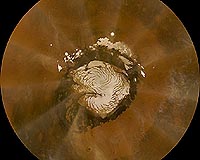 mars-mers 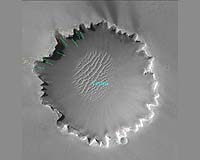 |
 Moffett Field CA (SPX) Oct 14, 2008
Moffett Field CA (SPX) Oct 14, 2008As fall approaches Mars' northern plains, NASA's Phoenix Lander continues to dig into the red planet's soil and deliver samples to its onboard science instruments for analysis. Over the past two weeks, Phoenix's nearly 2.4-meter-long (8 foot) arm moved a rock named "Headless" about 0.4 meters (16 inches) and snapped an image of the rock with its camera. Then the robotic arm scraped the ... more India Not Engaged In Space Race With China  Bangalore, India (PTI) Oct 13, 2008
Bangalore, India (PTI) Oct 13, 2008As India prepares for its first unmanned mission to the Moon next week, ISRO chief Madhavan Nair has said that New Delhi is not engaged in a space race with Beijing, stating that the priorities of the two countries are different and there is no competition. Chandrayaan-1, the country's first unmanned lunar venture, is slated for launch on October 22 and India has proposed Mars mission in ... more NASA Supercomputer Shows How Dust Rings Point To Exo-Earths  Greenbelt MD (SPX) Oct 13, 2008
Greenbelt MD (SPX) Oct 13, 2008Supercomputer simulations of dusty disks around sunlike stars show that planets nearly as small as Mars can create patterns that future telescopes may be able to detect. The research points to a new avenue in the search for habitable planets. "It may be a while before we can directly image earthlike planets around other stars but, before then, we'll be able to detect the ornate and ... more What Will Flight To Mars Reveal  Moscow (RIA Novosti) Oct 13, 2008
Moscow (RIA Novosti) Oct 13, 2008Deep space exploration is becoming an ever bigger part of national space programs. Currently, missions to the Moon and Mars are considered feasible. The U.S. has announced preparation for another space probe launch to collect data from the Martian atmosphere, scheduled for 2013. In Russia, Martian exploration is confined to ground tests so far. The project Mars-500, aimed at determining ... more |
mars-general
 mars-odyssey  mars-lab 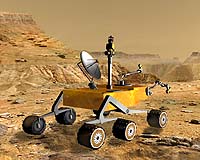 |
 Pasadena CA (SPX) Oct 10, 2008
Pasadena CA (SPX) Oct 10, 2008As fall approaches Mars' northern plains, NASA's Phoenix Lander is busy digging into the Red Planet's soil and scooping it into its onboard science laboratories for analysis. Over the past two weeks, Phoenix's nearly 2.4-meter-long (8 feet) arm moved a rock, nicknamed "Headless," about 0.4 meters (16 inches), and snapped an image of the rock with its camera. Then, the robotic arm ... more An Opportunity For A Tour Will Be An Endeavour  Pasadena CA Oct 04, 2008
Pasadena CA Oct 04, 2008Opportunity has embarked on the next great challenge -- a journey of 12 kilometers (7.5 miles) southeast to a huge hole in the ground nicknamed "Endeavour Crater." Measuring 22 kilometers (14 miles) from rim to rim and plunging 300 meters (1,000 feet) below the surface, Endeavour Crater is significantly larger than "Victoria Crater," which is 730 meters (almost half a mile) wide and 70 meters (2 ... more Nicaraguan Volcano Provides Insight Into Early Mars  Moffett Field CA (SPX) Oct 01, 2008
Moffett Field CA (SPX) Oct 01, 2008Volcanic eruptions were commonplace on ancient Mars, when vents and fissures spewed out gases like water vapor, carbon dioxide, sulfur dioxide, and hydrogen sulfide. Such locales were very hot and very acidic - characteristics that would seem to be inhospitable to life. But in recent years researchers have discovered a vast array of primitive organisms living in analogous environments on Earth. ... more Mars Lander Sees Falling Snow, Soil Data Suggest Liquid Past  Pasadena CA (SPX) Sep 30, 2008
Pasadena CA (SPX) Sep 30, 2008NASA's Phoenix Mars Lander has detected snow falling from Martian clouds. Spacecraft soil experiments also have provided evidence of past interaction between minerals and liquid water, processes that occur on Earth. A laser instrument designed to gather knowledge of how the atmosphere and surface interact on Mars has detected snow from clouds about 4 kilometers (2. 5 miles) above the ... more
|
mars-water-science
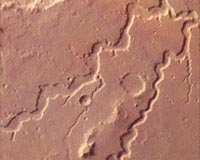 mars-mers 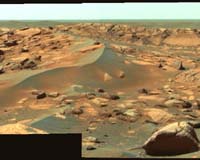 mars-mers 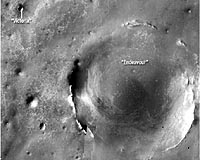 |
| Previous Issues | Oct 19 | Oct 18 | Oct 17 | Oct 16 | Oct 15 |
| The contents herein, unless otherwise known to be public domain, are Copyright 1995-2007 - SpaceDaily. AFP and UPI Wire Stories are copyright Agence France-Presse and United Press International. ESA Portal Reports are copyright European Space Agency. All NASA sourced material is public domain. Additional copyrights may apply in whole or part to other bona fide parties. Advertising does not imply endorsement, agreement or approval of any opinions, statements or information provided by SpaceDaily on any web page published or hosted by SpaceDaily. Privacy statement |